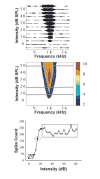Reorganization of receptive fields following hearing loss in inferior colliculus neurons
- PMID: 17540507
- PMCID: PMC2614669
- DOI: 10.1016/j.neuroscience.2007.04.031
Reorganization of receptive fields following hearing loss in inferior colliculus neurons
Abstract
We explored frequency and intensity encoding in the inferior colliculus (IC) of the C57 mouse model of sensorineural hearing loss. Consistent with plasticity reported in the IC of other models of hearing loss, frequency response areas (FRAs) in hearing-impaired (HI) mice were broader with fewer high-frequency units than normal-hearing (NH) mice. The broad FRAs recorded from HI mice had lower cutoffs on the low frequency edge of the FRA. Characteristic frequency (CF) and sharpness of tuning (Q10) calculated from the FRA were used to divide the sample into four categories: low-CF sharp-FRA, low-CF broad-FRA, high-CF sharp-FRA, and high-CF broad-FRA units. Rate-intensity functions (RIFs) for CF tones and noise were used to determine the minimum and maximum response counts as well as the sound pressure levels resulting in 10%, 50%, and 90% of the maximum spike count. Tone RIFs of broad FRA units were shifted to the right of tone RIFs of sharp FRA units in both NH and HI mouse IC, regardless of the unit CF. The main effects of hearing loss were seen in the noise RIFs. The low-CF broad-FRA units in HI mice had elevated responses to noise, and the high-CF sharp-FRA units in HI mice had lower maximum rates, as compared with the units recorded from NH mice. These results suggest that, as the IC responds to peripheral hearing loss with changes in the representation of frequency, an altered balance between inhibitory and excitatory inputs to the neurons recorded from the HI mice alters aspects of the units' intensity encoding. This altered balance likely occurs, at least in part, outside of the IC.
Figures






Similar articles
-
Physiology of the young adult Fischer 344 rat inferior colliculus: responses to contralateral monaural stimuli.Hear Res. 1996 Oct;100(1-2):41-58. doi: 10.1016/0378-5955(96)00115-3. Hear Res. 1996. PMID: 8922979
-
The immediate effects of acoustic trauma on excitation and inhibition in the inferior colliculus: A Wiener-kernel analysis.Hear Res. 2016 Jan;331:47-56. doi: 10.1016/j.heares.2015.10.007. Epub 2015 Oct 30. Hear Res. 2016. PMID: 26523371
-
Hyperexcitability of inferior colliculus and acoustic startle reflex with age-related hearing loss.Hear Res. 2017 Jul;350:32-42. doi: 10.1016/j.heares.2017.03.011. Epub 2017 Mar 27. Hear Res. 2017. PMID: 28431308 Free PMC article.
-
Functional reorganization in chinchilla inferior colliculus associated with chronic and acute cochlear damage.Hear Res. 2002 Jun;168(1-2):238-49. doi: 10.1016/s0378-5955(02)00360-x. Hear Res. 2002. PMID: 12117524 Review.
-
Hearing loss-related altered neuronal activity in the inferior colliculus.Hear Res. 2024 Aug;449:109033. doi: 10.1016/j.heares.2024.109033. Epub 2024 May 20. Hear Res. 2024. PMID: 38797036 Review.
Cited by
-
Sensorineural hearing loss and neural correlates of temporal acuity in the inferior colliculus of the C57BL/6 mouse.J Assoc Res Otolaryngol. 2008 Mar;9(1):90-101. doi: 10.1007/s10162-007-0101-z. Epub 2007 Nov 10. J Assoc Res Otolaryngol. 2008. PMID: 17994264 Free PMC article.
-
Effects of Sensorineural Hearing Loss on Cortical Synchronization to Competing Speech during Selective Attention.J Neurosci. 2020 Mar 18;40(12):2562-2572. doi: 10.1523/JNEUROSCI.1936-19.2020. Epub 2020 Feb 24. J Neurosci. 2020. PMID: 32094201 Free PMC article.
-
Does hearing loss lead to dementia? A review of the literature.Hear Res. 2021 Mar 15;402:108038. doi: 10.1016/j.heares.2020.108038. Epub 2020 Jul 30. Hear Res. 2021. PMID: 32814645 Free PMC article. Review.
-
Increasing GABA reverses age-related alterations in excitatory receptive fields and intensity coding of auditory midbrain neurons in aged mice.Neurobiol Aging. 2017 Aug;56:87-99. doi: 10.1016/j.neurobiolaging.2017.04.003. Epub 2017 Apr 12. Neurobiol Aging. 2017. PMID: 28532644 Free PMC article.
-
Loss of the Cochlear Amplifier Prestin Reduces Temporal Processing Efficacy in the Central Auditory System.Front Cell Neurosci. 2018 Sep 21;12:291. doi: 10.3389/fncel.2018.00291. eCollection 2018. Front Cell Neurosci. 2018. PMID: 30297983 Free PMC article.
References
-
- Aitkin L, Tran L, Syka J. The responses of neurons in subdivisions of the inferior colliculus of cats to tonal, noise and vocal stimuli. Exp Brain Res. 1994;98:53–64. - PubMed
-
- Alkhatib A, Biebel UW, Smolders JW. Inhibitory and excitatory response areas of neurons in the central nucleus of the inferior colliculus in unanesthetized chinchillas. Exp Brain Res. 2006;174:124–143. - PubMed
-
- Barsz K, Benson PK, Walton JP. Gap encoding by inferior collicular neurons is altered by minimal changes in signal envelope. Hear Res. 1998;115:13–26. - PubMed
-
- Caspary DM, Holder TM, Hughes LF, Milbrandt JC, McKernan RM, Naritoku DK. Age-related changes in GABA(A) receptor subunit composition and function in rat auditory system. Neuroscience. 1999;93:307–312. - PubMed
-
- Caspary DM, Milbrandt JC, Helfert RH. Central auditory aging: GABA changes in the inferior colliculus. Exp Gerontol. 1995;30:349–360. - PubMed
Publication types
MeSH terms
Grants and funding
LinkOut - more resources
Full Text Sources

